Altar-ed images: Peter Marlow on England's cathedrals
21 April 2016
After completing a commission to photograph six English cathedrals for a collection of Royal Mail stamps, Peter Marlow was inspired to continue and photograph all 42 Church of England cathedrals. In doing so, the simplicity of the approach and techniques he applied not only recorded the architectural beauty of each venue but captured them as spaces dedicated to contemplation, devotion and reflection. With an exhibition of these works due to take place in one of the featured locations, Coventry Cathedral, NATALIE BUSHE casts an eye over this singular collection of work.
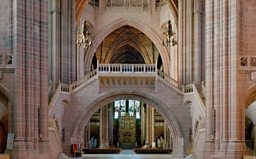
After a celebrated career in photojournalism working for the agencies Sygma and Magnum, and a move into portraiture for The Sunday Times, renowned photographer and chronicler Peter Marlow died in February this year while completing work on his upcoming exhibition The English Cathedral, which is opening on 29th April in The Chapel of Christ the Servant, Coventry Cathedral.
Notable for his studies of contemporary British life - including Liverpool - Looking out to Sea, a long-term survey of 80s inner-city decline - Peter Marlow began his career as a photojournalist for Sygma, capturing the conflict in Northern Ireland and Lebanon in the mid 1970s. But he soon started to question the ethics and environment of reportage and look for a more reflective approach to photography.
I began by photographing the aesthetic highlights of each building, but the images seemed to merge with one anotherPeter Marlow
Marlow joined Magnum in 1980, and with fellow photographer Chris Steele-Perkins he founded the London office.
He was known as the peacemaker amongst his colleagues and Magnum described Marlow as “part of the essential glue that has held us all together”.
Marlow’s reputation for portraiture flourished while working for The Sunday Times, and he created iconic images of the politically venerated and vilified - including Margaret Thatcher, Tony Blair and more recently David Cameron.
In 2008, Marlow was commissioned by Royal Mail, on the occasion of the 300th anniversary of the completion of St Paul’s Cathedral, to photograph six cathedrals.
The resulting images of Lichfield, Belfast, Gloucester, St David's, Westminster, and St Magnus in Orkney were issued as a set of six commemorative stamps.
So inspired by the commission was Marlow that he decided to photograph all 42 cathedrals of the Church of England. It took him four years to complete, and would be his last collection curated when alive.
In his accompanying book The English Cathedral, Marlow described his approach to the project: "I began by photographing the aesthetic highlights of each building, but the images seemed to merge with one another. In order to differentiate each place I needed to find a more rigorous and systematic approach, so I adopted the simple strategy of photographing the naves looking along the central axis."

Shot on large format film, Marlow developed the method of shooting a majority of the cathedrals from the same position: looking east towards the altar as the natural light of dawn broke through the main window.
I want my work to generate a sense of the unexpected, the hidden, and the seemingly spontaneousPeter Marlow
What Marlow captures in the early morning light are the interiors of the most theatrical of buildings, built for awe and reverence.
It was Marlow’s intention that, “by blending observation and wit with reason, I want my work to generate a sense of the unexpected, the hidden, and the seemingly spontaneous”.
No matter when a cathedral dates from, its vaulted ceiling is designed to lift the eyes upward in heavenly worship and adoration.
Marlow’s photography highlights the great stone canopies and forests of columns, appearing almost infinite in their support of the divine.
The images are clinical in their depiction of cathedral style and space, either detailing early Romanesque or Gothic design, or, by the 1300s, adopting the classical Renaissance and harking back to the structures of ancient Rome.
Birmingham Cathedral’s ornate baroque interior is particularly joyous in contrast to the towering stoicism of Canterbury, or simple grandeur of Durham.
Though Coventry’s sleek modern walls are devoid of the hiding places, additional altars and isles of the pre-Reformation, it is equally as eye-catching and its glorious wooden canopy still draws the eye heavenward.

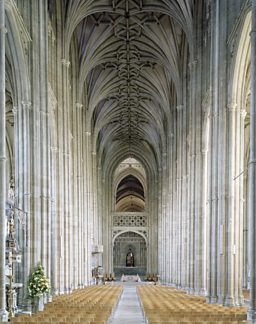
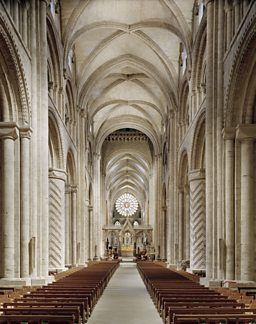
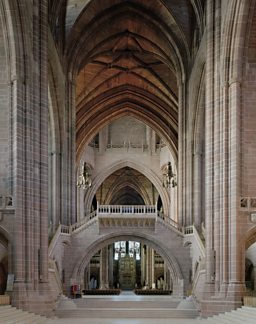
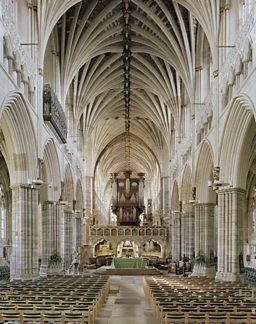

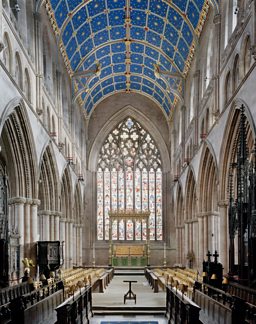


More from BBC Arts
-
![]()
Picasso’s ex-factor
Who are the six women who shaped his life and work?
-
![]()
Quiz: Picasso or pixel?
Can you separate the AI fakes from genuine paintings by Pablo Picasso?
-
![]()
Frida: Fiery, fierce and passionate
The extraordinary life of Mexican artist Frida Kahlo, in her own words
-
![]()
Proms 2023: The best bits
From Yuja Wang to Northern Soul, handpicked stand-out moments from this year's Proms
The English Cathedral by Peter Marlow opens 29 April – 5 September 2016 in Coventry Cathedral, and Peter's book The English Cathedral has just been published in a new smaller size by Merrell.
More photography from BBC Arts
-
![]()
War and peace
The compassionate photography of Don McCullin.
-
![]()
Childhood in the 1970s
Tish Murtha’s tender photos of deprivation in Britain.
-
![]()
Neon dreamland
Liam Wong's sci-fi-style images of Tokyo at night.
-
![]()
Pup art
William Wegman's Polaroids of his loyal Weimaraners.
-
![]()
Stanley Kubrick
1940s New York through the lens of teenage Stanley Kubrick.
-
![]()
Jailhouse Rock
Behind-the-scenes photos of Johnny Cash's prison shows.
-
![]()
The real Sin City
Hard-boiled photographs tell the history of crime in LA.
-
![]()
10 years with Kate Bush
Rare photographs of the singer at the height of her career.
















